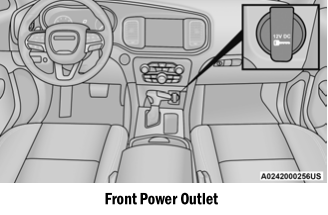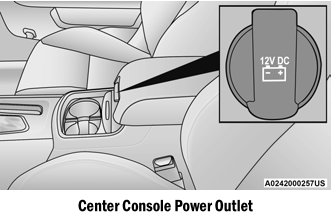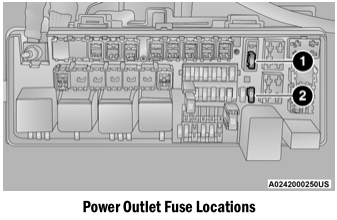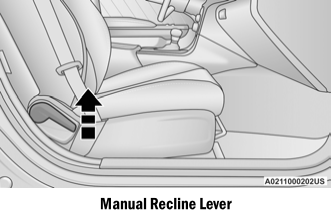Dodge Charger: INTERIOR STORAGE AND EQUIPMENT / Power Outlets
Your vehicle is equipped with 12 Volt (15 Amp) power outlets that can be used to power cellular phones, small electronics and other low powered electrical accessories. The power outlets are labeled with either a “key” or a “battery” symbol to indicate how the outlet is powered. Power outlets labeled with a “key” are powered when the ignition is in the ON or ACC position, while the outlets labeled with a “battery” are connected directly to the battery and powered at all times.
NOTE:
All accessories connected to the “battery” powered outlets should be removed or turned off when the vehicle is not in use to protect the battery against discharge.
CAUTION!
Power outlets are designed for accessory plugs only. Do not insert any other object in the power outlets as this will damage the outlet and blow the fuse. Improper use of the power outlet can cause damage not covered by your New Vehicle Limited Warranty.
The front power outlet is located inside the storage area on the center stack of the instrument panel.

In addition to the front power outlet, there is also a power outlet located in the storage area of the center console.

If the Media Hub is in use, do not exceed the maximum power of 100 Watts (8 Amps) for the center console power outlet. When the Media Hub is not in use, the outlet can deliver up to 160 Watts (13 Amps). If the power rating is exceeded, the fuse protecting the system needs to be replaced.
NOTE:
The instrument panel power outlet and dual rear console USB ports can be changed to “battery” (powered all the times) by moving the #12 20 Amp fuse from “IGN” to “B+”.

- #12 Fuse 20 Amp Yellow Instrument Panel Power Outlet/Dual USB Charge Only Ports
- #38 Fuse 20 Amp Yellow Center Console Power Outlet/Media Hub
WARNING!
To avoid serious injury or death:
- Only devices designed for use in this type of outlet should be inserted into any 12 Volt outlet.
- Do not touch with wet hands.
- Close the lid when not in use and while driving the vehicle.
- If this outlet is mishandled, it may cause an electric shock and failure.
CAUTION!
- Many accessories that can be plugged in draw power from the vehicle's battery even when not in use (i.e., cellular phones, etc.). Eventually, if plugged in long enough, the vehicle's battery will discharge sufficiently to degrade battery life and/or prevent the engine from starting.
- Accessories that draw higher power (i.e., coolers, vacuum cleaners, lights, etc.) will degrade the battery even more quickly. Only use these intermittently and with greater caution.
- After the use of high power draw accesso- ries or long periods of the vehicle not being started (with accessories still plugged in), the vehicle must be driven a sufficient length of time to allow the alternator to recharge the vehicle's battery.
- Power outlets are designed for accessory plugs only. Do not hang any type of acces- sory or accessory bracket from the plug. Improper use of the power outlet can cause damage.
 Illuminated Cupholders — If Equipped
Illuminated Cupholders — If Equipped
On some vehicles the front and/or rear cupholders are equipped with a light ring
that illuminates the cupholders. The brightness of the light rings are controlled
by the Dimmer Control...
 WINDOWS
WINDOWS
..
Other information:
Dodge Charger 2011-2025 Owner's Manual: Ignition Park Interlock
This vehicle is equipped with an Ignition Park Interlock which requires the transmission to be in PARK before the ignition can be turned to the OFF mode. This helps the driver avoid inadvertently leaving the vehicle without placing the transmission in PARK...
Dodge Charger 2011-2025 Owner's Manual: Adaptive Cruise Control (ACC) Operation
T..
Categories
- Manuals Home
- Dodge Charger Owners Manual
- Dodge Charger Service Manual
- Opening And Closing The Trunk
- ELECTRIC POWER STEERING
- Launch Control
- New on site
- Most important about car
Manual Front Seat Recline
To adjust the seatback, lift the lever located on the outboard side of the seat, lean back to the desired position and release the lever. To return the seatback, lift the lever, lean forward and release the lever.

